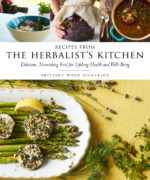Recipes from the Herbalist’s Kitchen: Delicious, Nourishing Food for Lifelong Health and Well-Being. / Brittany Wood Nickerson. Storey Publications, 2017. 303 pages, illustrations in color.

 This cookbook is rated Omnivore and Vegetarian-friendly by Lotus Lady and Verse.
This cookbook is rated Omnivore and Vegetarian-friendly by Lotus Lady and Verse.
A brilliant and heartfelt message by an herbalist-educator-chef whose book Recipes from the Herbalist’s Kitchen will have you captivated and involved. You’ll pick up tips on the 5 tastes we recognize as flavors. You’ll discover how herbal preparations used in recipes substantially add to your kitchen repertoire. And you’ll marvel at how interconnected herbs and health are in tandem with the food you prepare.
“Awaken”, “Nourish”, “Invigorate”, “Comfort” and more, Nickerson’s chapter headings are legends that speak of thriving, of balancing your energy with all of the influences that make up your day. Right away you realize this is no ordinary cookbook. Nickerson is committed to a message that can actually help you steer your life in a positive direction. Her belief is that we need to be involved in creating a healthy lifestyle—not by purchasing it outright, but by experience, gaining access to the wealth of properties in herbs and foods that we can cultivate ourselves.
Cultivating usually means growing and harvesting. But if that’s not possible on any scale, there’s still the goal of incorporating herbs into our meals at home. Choosing tastes from fruits and vegetables that reflect the seasons and being mindful of cultivating the five tastes in every meal would help to curb cravings. Curbing cravings itself is an objective that says we’ll be more comfortable between meals, less likely to keep putting on weight, etc.
The “sweet” taste is the first of the five we usually speak about. Sweet is on everyone’s mind—practically all the time but especially at this time of year! In fact the sweet taste in Ayurveda makes sweet foods irresistible in early and late winter. And there are good reasons for it—sweet, a taste, denotes the nourishing flavor—something we need when weather is cold. And humans like sweet generally more than other flavors.
You know the sweet taste in fruits, grains, milk, milk alternatives like rice and almond, root vegetables, and winter squashes, etc. But did you know that eating these foods and balancing their sweetness with pungent (basil, cinnamon, ginger, turmeric) or even salty tasting herbs (celery, cumin, coriander seed, cilantro, parsley, etc.) will lead to better digestion and health?
What drew me to the text, aside from ingredients, in Recipes from the Herbalist’s Kitchen was Nickerson’s mix of recipes: for herbal teas, tinctures, butters, vinegars, oils, honeys and syrups you can use in specified recipes—like “Herb-Infused Honey” is part of the recipe for “Hazelnut Cornmeal Cake with Rosemary Honey”, or instead make a simple “Sage Honey”, a salve for the mind (calming) or for a cold (an immunity balm).
Make an herbal preparation you can use immediately, or add it to one of the recipes. So you double the benefits for your efforts!
And then I came across inserts Nickerson provides that could enrich your outlook on the cooking process. Cookbook authors use mini-essays to spark your interest, but in this case, you’re getting much more than tips on kitchen ingredients. Author Nickerson’s commitment to “empower people” is honest and actually works. It got me to understand why I’m always thirsty—it may be partly because I eat and drink lots of astringent-tasting foods and teas.
When Nickerson puts forward ideals from Ayurveda such as “Establish being, perform action” (p. 73) you are in for a treat of a more mindful or even more spiritual nature. Wouldn’t you like to feel connected with the forces of nature that provide health and well-being?
See Brittany Wood Nickerson, who also studied Chinese and Western herbal medicine, at her website at Thyme Herbal.



